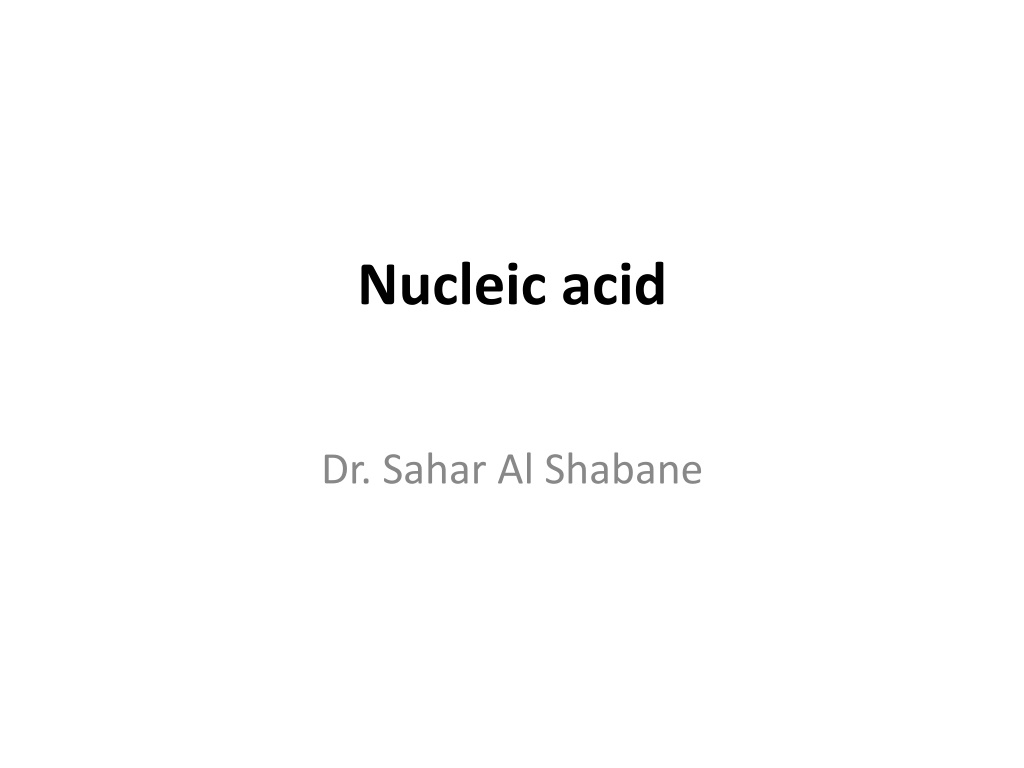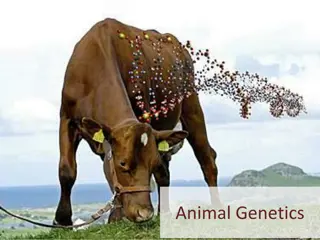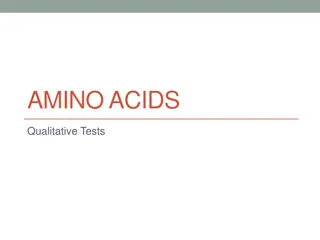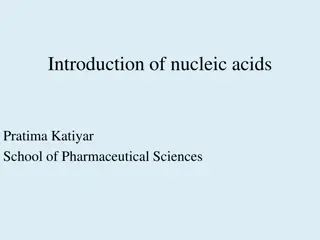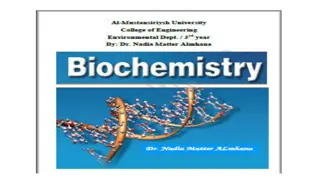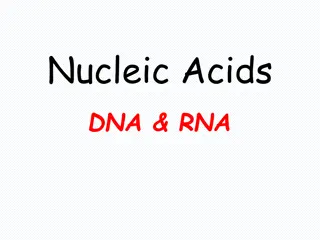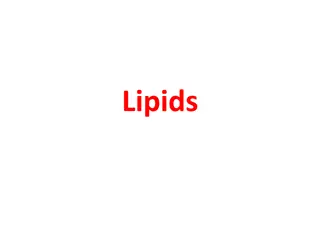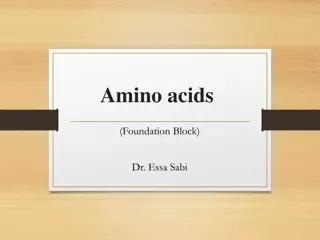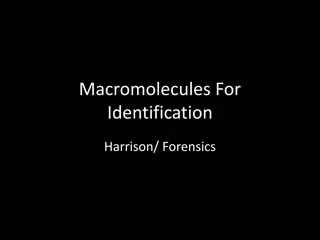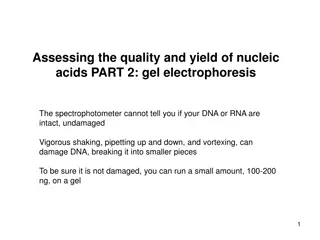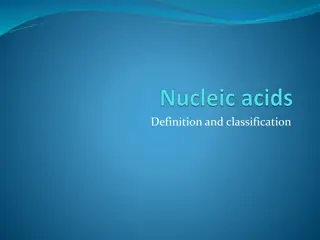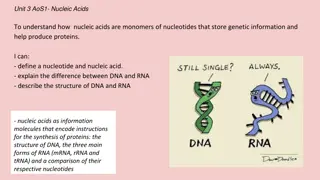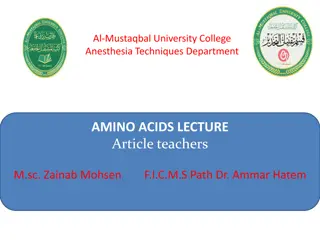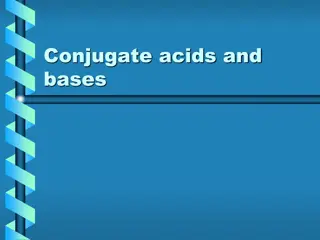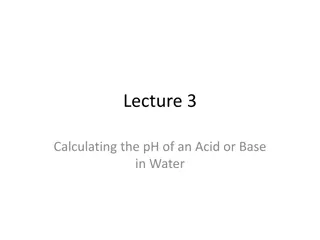Understanding Nucleic Acids: The Building Blocks of Life
Nucleic acids, such as DNA and RNA, play a crucial role in storing and transmitting genetic information in living organisms. These biopolymers are composed of nucleotides, each consisting of a sugar, phosphate group, and nitrogenous base. DNA and RNA differ in sugar composition and nucleobases. Nucleic acids are long polymers that vary in size, with DNA being one of the largest molecules known. They function in encoding, transmitting, and expressing genetic information, essential for life. Explore the molecular composition, structure, and significance of nucleic acids in this insightful overview.
Download Presentation

Please find below an Image/Link to download the presentation.
The content on the website is provided AS IS for your information and personal use only. It may not be sold, licensed, or shared on other websites without obtaining consent from the author. Download presentation by click this link. If you encounter any issues during the download, it is possible that the publisher has removed the file from their server.
E N D
Presentation Transcript
Nucleic acid Dr. Sahar Al Shabane
Nucleic acids are biopolymers, or large biomolecules, essential for known forms of life. include DNA (deoxyribonucleic acid) and RNA (ribonucleic acid), are made from monomers known as nucleotides. Each nucleotide has three components: 1- 5-carbon sugar . 2- Phosphate group . 3-Nitrogenous base. all Nucleic acids, which They are found in abundance in all living things, where they function in: 1-Encoding. 2-Transmitting. 3-Xpressing genetic information.
Strings of nucleotides strung together in a specific sequence are the mechanism for storing and transmitting hereditary, or genetic information via protein synthesis. https://upload.wikimedia.org/wikipedia/commons/thumb/3/37/Difference_DNA_RNA-EN.svg/350px-Difference_DNA_RNA-EN.svg.png Figure 1:A comparison of the two principal nucleic acids: RNA (left) and DNA (right), showing the helices and nucleobases each employs.
Molecular composition and size Nucleic acids are generally very large molecules. DNA molecules are probably the largest individual molecules known. Well- studied biological nucleic acid molecules range in size from 21 nucleotides (small interfering RNA) to large chromosomes (human chromosome 1 is a single molecule that contains 247 million base pairs). In most cases, naturally occurring DNA molecules are double- stranded and RNA molecules are single-stranded.
Nucleic acids are linear polymers (chains) of nucleotides. Each nucleotide consists of three components: 1- Purine or pyrimidine nucleobase (sometimes termed nitrogenous base or simply base). 2- Pentose sugar . 3- Phosphate group. The substructure consisting of a nucleobase plus sugar is termed a nucleoside. Nucleic acid types differ in the structure of the sugar in 2'-deoxyribose while their nucleotides DNA contains RNA contains ribose (where the only difference is the presence of a hydroxyl group). Also, the nucleobases found in the two nucleic acid types are different: adenine, cytosine, and guanine are found in both RNA and DNA, while thymine occurs in DNA and uracil occurs in RNA.
https://www2.chemistry.msu.edu/faculty/reusch/VirtTxtJml/Images3/hetbase1.gifhttps://www2.chemistry.msu.edu/faculty/reusch/VirtTxtJml/Images3/hetbase1.gif
A T G C sugar phosphate sugar phosphate sugar phosphate sugar ... Chemical Structure of the DNA Nucleotides These nucleotides bind to the sugar backbone of the molecule as follows: The sugars and phosphates in nucleic acids are connected to each other in an alternating chain (sugar-phosphate backbone) through phosphodiester linkages. carbons to which the phosphate groups attach are the 3'-end and the 5'- end carbons of the sugar. This gives nucleic acids directionality, and the ends of nucleic acid molecules are referred to as 5'-end and 3'-end. The nucleobases are joined to the sugars via an N-glycosidic linkage involving a nucleobase ring nitrogen (N-1 for pyrimidines and N-9 for purines) and the 1' carbon of the pentose sugar ring. In conventional nomenclature, the
https://www2.chemistry.msu.edu/faculty/reusch/VirtTxtJml/Images3/dna_rna1.gifhttps://www2.chemistry.msu.edu/faculty/reusch/VirtTxtJml/Images3/dna_rna1.gif
The versatility of DNA comes from the fact that the molecule is actually double-stranded. The nucleotide bases of the DNA molecule form complementary pairs: The nucleotides hydrogen bond to another nucleotide base in a strand of DNA opposite to the original. This bonding is specific, and adenine always bonds to thymine (and vice versa) and guanine always bonds to cytosine (and vice versa).
This bonding occurs across the molecule, leading to a double- stranded system as pictured below: sugar phosphate suga phosphate sugar phosphate sugar ... r T A C G A T G C sugar phosphate sugar phosphate sugar phosphate sugar ...
Types of nucleic acids: Deoxyribonucleic acid Deoxyribonucleic acid (DNA) is a nucleic acid containing the genetic instructions used in the development and functioning of all known living organisms. The DNA segments carrying this genetic information are called genes Likewise, other DNA sequences have structural purposes, or are involved in regulating the use of this genetic information. Along with RNA and proteins, DNA is one of the three major macromolecules that are essential for all known forms of life. DNA consists of two long polymers of simple units called nucleotides, with backbones made of sugars and phosphate groups joined by ester bonds. These two strands run in opposite directions to each other and are, therefore, anti-parallel. Attached to each sugar is one of four types of molecules called nucleobases (informally, bases)
It is the sequence of these four nucleobases along the backbone that encodes information. This information is read using the genetic code, which specifies the sequence of the amino acids within proteins. The code is read by copying stretches of DNA into the related nucleic acid RNA in a process called transcription.
Within cells DNA is organized into long structures called chromosomes. During cell division these chromosomes are duplicated in the process of DNA replication, providing each cell its own complete set of chromosomes. Eukaryotic organisms (animals, plants, fungi, and protists) store most of their DNA inside the cell nucleus and some of their DNA in organelles, such as mitochondria or chloroplasts. In contrast, prokaryotes (bacteria and archaea) store their DNA only in the cytoplasm. Within the chromosomes, chromatin proteins such as histones compact and organize DNA. These compact structures guide the interactions between DNA and other proteins, helping control which parts of the DNA and transcribed
Ribonucleic acid(RNA) Ribonucleic acid (RNA) functions in converting genetic information from genes into the amino acid sequences of proteins. The three universal types of RNA include: 1-Transfer RNA (tRNA) . 2-Messenger RNA (mRNA). 3-Ribosomal RNA (rRNA). Messenger RNA: acts to carry genetic sequence information between DNA and ribosomes, directing protein synthesis. Ribosomal RNA: is a major component of the ribosome, and catalyzes peptide bond formation. Transfer RNA: serves as the carrier molecule for amino acids to be used in protein synthesis, and is responsible for decoding the mRNA.
